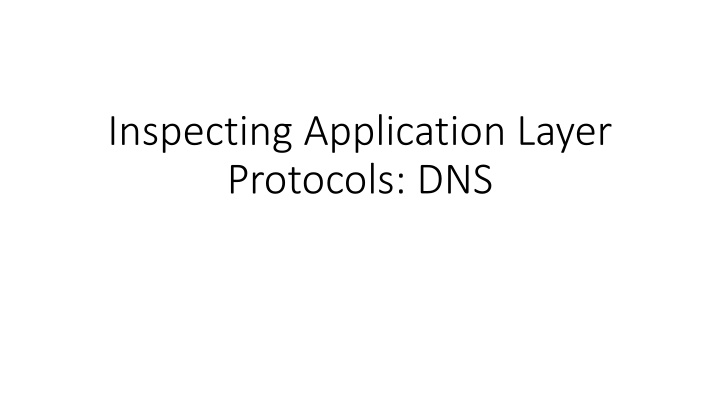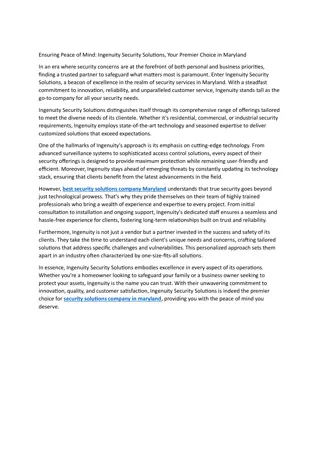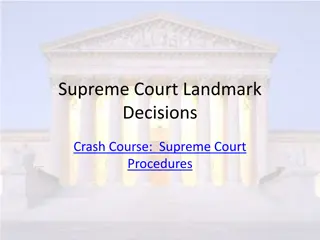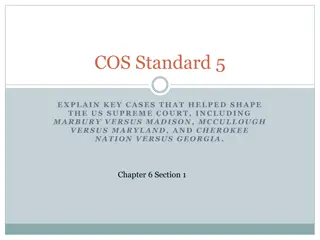Maryland's ImmuNet Webinar Training Overview
Explore the features of Maryland's ImmuNet system through this comprehensive webinar training, covering topics such as editing VFC profiles, submitting inventory reports, ordering vaccines, and managing ImmuNet inventory. Learn about the purpose of ImmuNet, new mandates for VFC providers, online ordering capabilities, and upcoming enhancements for an improved user experience. Get insights on logging in and utilizing the platform effectively.
Download Presentation

Please find below an Image/Link to download the presentation.
The content on the website is provided AS IS for your information and personal use only. It may not be sold, licensed, or shared on other websites without obtaining consent from the author.If you encounter any issues during the download, it is possible that the publisher has removed the file from their server.
You are allowed to download the files provided on this website for personal or commercial use, subject to the condition that they are used lawfully. All files are the property of their respective owners.
The content on the website is provided AS IS for your information and personal use only. It may not be sold, licensed, or shared on other websites without obtaining consent from the author.
E N D
Presentation Transcript
Inspecting Application Layer Protocols: DNS
Contents DNS: Domain Name Sever Breaking Down DNS Types (RR) Common DNS RR Types Examining the RR structure Reviewing the DNS packet
DNS: Domain Name Sever The Domain Name System (DNS) converts a human-readable hostname into an Internet Protocol (IP) address. It is one of the most common application layer protocols in use today and is essential to any network.
Breaking Down DNS Types Breaking down DNS types Whenever you send a request to a DNS server, the request will include the type of record to return (RR). Although there are many types of DNS RR, we'll take a look at some common types. For a comprehensive list of DNS types, visit: https://phoenixnap.com/kb/dns-record-types
Examining the RR structure The structure of all RRs contains elements that describe the RR, as shown in the following table:
Example of an RR answer in a DNS response packet CloudShark (https://www. cloudshark.org/captures/13833cdd14ba). Download the file, DNS Question & Answer.pcapng, and open it in Wireshark.
Reviewing the DNS packet The first section (1) is the DNS header. The second section (2) summarizes the contents. The third section (3) is the query section. The fourth section (4) are Wireshark- specific references.
Examining the header When examining the header fields, you will see two main sections: Transaction ID Flags
Transaction ID Transaction ID is an essential element of a DNS packet, as it identifies the specific DNS transaction during the exchange of the query and response packets. Wireshark keeps track of Transaction ID so that you can easily reference parts of the transaction.
Comparing the Flags When comparing the flags in a DNS header, you will see a distinct difference between the packet coming from the client and the packet coming from the server.
The Flags From the Client Response: Set at 0, which indicates that the message is a query. OpCode: For most requests, the Operation code (OpCode) is 0, which indicates this is a standard query. Truncated: When set at 0, this means the message is not truncated. Recursion desired: When set at 1, this will indicate that the client requests recursion. Z: A deprecated flag that was used in outdated DNS implementations. Non-authenticated data: Set at 0, as this flag is used only in a response packet.
The Flags From the Server Response: Set at 1, which indicates that the message is a response. OpCode: For most responses, the OpCode is 0, which indicates this is a standard query. Authoritative: Indicates whether the server is an authority for the domain. When set at 0, this indicates the server is not an authority for the domain. Truncated: When set at 0, this means the message is not truncated. Recursion desired: When set at 1, this will indicate that the client requests recursion. Recursion available: When set at 1, this will indicate that the server can do recursive queries. Z: A deprecated flag that was used in outdated DNS implementations. Answer authenticated: Will indicate whether the answer/authority portion was authenticated by the server. Non-authenticated data: Used in a response packet. If the value is set to 1, this will indicate that all data included has been authenticated by the DNS server. Reply code: 0 will indicate that there is no error.
OpCode Flag The OpCode flag will indicate the type of message that is being sent, as it issues a command to the DNS server to perform some action. Let's take a look.
Requesting Recursion There are two types of queries in: DNS recursive and iterative. Whenever the client submits a DNS query, it's common to see the following flag set Recursion desired: Do query recursively. A recursive query is the preferred option, as when available, the DNS server will do the work of obtaining the response. In contrast, an iterative query is for when the client must do the work of obtaining the response.
Requesting Recursion When the server responds, it will reply with either of the following: Recursion Available where the flag is set at 1, which means the server will complete a recursive query . Recursion Not Available where the flag is set at 0, which means the server will not complete a recursive query, as this type of query is not supported.
Dissecting the packet structure The four sections that follow the DNS header, for either a query or response, are as follows: Questions: The requested resolution Answers RRs: The number of RRs that provide the answer(s) Authority RRs: The number of RRs that provide the IP address of an authoritative NS Additional RRs: The number of RRs that contain additional information
Outlining the Query Section When looking at DNS header details, the format for the DNS question is different than the DNS answer, as shown here:
Question Name: The requested resolution. In this case, the client would like a resolution of Google.com. Type: The type of RR. In this case, the client is requesting an A type or a Type A (IPv4) address. Class: The class of RR requested. In this case, the class is listed as IN, which is the most common QClass request.
Answers 11 response
Evaluating queries and responses Caching a response Within that response is the TTL value, which reflects how long the record can live in the cache before disappearing. It's common to see a wide range of TTL values for DNS RRs. To check your own cache on a Windows machine, open a Command Prompt and type ipconfig /displaydns.
Evaluating queries and responses Viewing DNS response times
Evaluating queries and responses Testing using nslookup Once in the command-line interface, type nslookup example.com, and then press Enter. Once run, my output was as follows
Securing DNS Poisoning the cache: DNS is essential to any network. When clients request an IP address, they are trusting the server to provide an accurate address. If the address is incorrect, the client might be redirected to a bogus site. - Poisoning DNS server cache - Poisoning the cache of an ISP server
Defending DNS DNS servers can represent a vulnerable target. To protect the server, the network administrator can employ a few techniques: Use cache locking, which controls how and when the cache can be overwritten. Restrict zone transfers to only respond to trusted servers. Use DNS Security Extensions (DNSSEC), which provide data authentication and integrity. Additionally, all other standard good practice techniques to secure DNS servers should be used. Techniques include keeping the servers updated and patched and using firewalls that restrict access to only authorized entities























